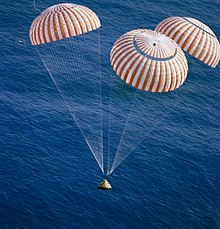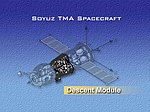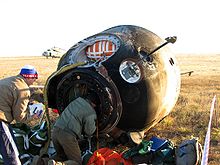Space capsule
This article has multiple issues. Please help improve it or discuss these issues on the talk page. (Learn how and when to remove these template messages)
|



A space capsule is an often crewed blunt-body spacecraft that reenters the Earth's atmosphere without wings. Capsules are distinguished from satellites primarily by the ability to survive reentry and return a payload to the Earth's surface from orbit. Capsules make up the majority of crewed spacecraft designs, although one crewed spaceplane has launched to orbit.
Current examples of crewed capsules include Soyuz, Shenzhou, Orion, CST-100, and Dragon 2. Future examples of crewed capsules include Federation. Historic examples of crewed capsules include Vostok, Mercury, Voskhod, Gemini, and the Apollo Command Module. A crewed space capsule must be able to sustain life in the vacuum of space, with an often demanding thermal and radiation environment. Many systems are necessary to accomplish this, including a reaction control system, an environmental/life support system, insulation, seats that can restrain weightless astronauts, communications antennas, docking hardware, a launch abort system, and more.[citation needed]
Shape and reentry

Space capsules have typically been smaller than 5 meters (16 feet) in diameter due to launch vehicle aerodynamic requirements. The capsule design is both volumetrically efficient and structurally strong, so it is typically possible to construct small capsules of performance comparable to lifting body or spaceplane designs in all but lift-to-drag ratio for less cost. The Soyuz spacecraft is an example.
Most space capsules have used an ablative heat shield for reentry and been non-reusable. The early spacecraft had a coating of glass embedded with synthetic resin and put in very high temperatures. Carbon fiber, reinforced plastics and high-temperature ceramic tiles or ultra-high temperature ceramic sheets are currently being evaluated for use in space exploration.[citation needed]
Space capsules are well-suited to high energy reentries. Capsules reenter aft-end first with the occupants lying down, as this is the optimum position for the human body to withstand the g-forces induced as the capsule impacts the atmosphere. The rounded shape (blunt body) of a capsule forms a shock wave that keeps most of the heat away from the heat shield, but a thermal protection system is still necessary. The space capsule must be strong enough to withstand reentry forces such as drag, and must reenter at a precise angle of attack to prevent a skip off the surface of the atmosphere of destructively high accelerations.
When the space capsule comes through the atmosphere the capsule compresses the air in front of it, which heats up to very high temperatures. The surface of a capsule can get to 1480 °C (2700 F) as it descends through the Earth's atmosphere. To prevent this heat from reaching interior structures, capsules are typically equipped with an ablative heat shield that melts and then vaporizes, removing the heat.
The Apollo Command Module reentered with the center of mass offset from the center line; this caused the capsule to assume an angled attitude through the air, providing lift that could be used for directional control. Reaction control system thrusters were used to steer the capsule by changing the lift vector.
Parachutes are used for the final descent, sometimes augmented by braking rockets if the capsule is designed to land on the Earth's surface. Examples of land landing capsules include the Soviet/Russian Soyuz and Chinese Shenzhou. Other capsules, such as Mercury, Gemini, Apollo, and Dragon, splash down in the ocean.[citation needed]
History
Vostok and Voskhod

The Soviet Union pursued a spaceflight program after announcing their intent to launch an uncrewed satellite at the International Geophysical Year conference in 1955. Subsequent space flights were not announced until after their successful completion. After sending a dog named Laika into orbit on Sputnik 2 on 3 November 1957, the Vostok program succeeded in launching Yuri Gargarin into space for a single orbit and recovering him safely on 12 April 1961.
The Vostok craft launched on a highly capable R-7 Semyorka-derived launch vehicle and were much heavier than the equivalent Mercury spacecraft. Details of the Vostok design were not publicly disclosed until four years after Gagarin's flight, and the identity of rocket and spacecraft chief designer Sergei Korolev was not disclosed until after his death in 1966. The capsule was a sphere completely covered in ablative heat shield material, 2.3 meters (7.5 ft) in diameter, weighing 2,460 kilograms (5,420 lb). The capsule was covered with a nose cone to maintain a low-drag profile for launch, with a cylindrical interior cabin approximately 1 meter (3.3 ft) in diameter nearly perpendicular to the capsule's longitudinal axis. The cosmonaut sat in an ejection seat with a separate parachute for escape during a launch emergency and landing during a normal flight. The capsule had its own parachute for landing on the ground. Although official sources stated that Gagarin had landed inside his capsule, a requirement for qualifying as a first crewed spaceflight under International Aeronautical Federation (IAF) rules, it was later revealed that all Vostok cosmonauts ejected and landed separately from the capsule. The capsule was serviced by an aft-facing conical equipment module 2.25 meters (7.4 ft) long by 2.43 meters (8.0 ft), weighing 2,270 kilograms (5,000 lb) containing nitrogen and oxygen breathing gasses, batteries, fuel, attitude control thrusters, and the retrorocket. It could support flights as long as ten days.[1] Six Vostok launches were successfully conducted, the last two pairs in concurrent flights. The longest flight was just short of five days, on Vostok 5 in June 14–19, 1963.[citation needed]

The flight of Voskhod 1 with a three-man crew was announced on 12 October 1964, with the Soviet press boasting of a "shirt-sleeve" atmosphere for the cosmonauts. Then, the flight of the two-person Voskhod 2 was announced on March 18, 1965, with cosmonaut Alexei Leonov performing the world's first EVA. However, no further flights of Voskhod were made.
When details of the Voskhod design were later revealed, it was simply a modification of the one-person Vostok, with a three-person rectangular cabin replacing the cylinder and larger retrorockets. The Voskhod 1 crew could not wear space suits because the spacecraft taxed the limits of the launch vehicle payload capability. The complete Voskhod spacecraft weighed 5,682 kilograms (12,527 lb). On Voskhod 2, one cosmonaut seat was replaced with a cumbersome, inflatable airlock (which gave Leonov much trouble reentering the capsule) necessitated by the inability of the capsule avionics to avoid overheating in the vacuum of space. The program was discontinued after two flights.[citation needed]
Project Mercury and Gemini

In 1958, the United States announced Project Mercury, a series of low Earth orbit missions. The Mercury Seven was selected to pilot them, with a single-person capsule being designed by a team led by Maxime Faget.[2] The McDonnell Aircraft company won the contract to build Mercury. The cone-shaped capsule was 6 feet (1.8 m) in diameter with a blunt-body shape and a heat shield at the base. Total capsule length was 10.8 feet (3.3 m), including a retrorocket pack strapped over the heat shield. The heaviest capsule had a gross mass of 3,000 pounds (1,400 kg), and was capable of just over one day of orbital flight. A 24.1-foot (7.3 m)-long launch escape tower was connected to the nose of the capsule at launch, containing a solid-fueled rocket capable of carrying the capsule away from the launch vehicle in case of an emergency. Capsules for suborbital flights used a radiative heat shield made of beryllium and were launched with the Mercury-Redstone Launch Vehicle. Orbital capsules used an ablative heat shield made of fiberglass embedded in an aluminum honeycomb matrix, and were launched with the Atlas LV-3B.
The US launched its first Mercury astronaut Alan Shepard on a suborbital flight almost a month after the first crewed orbital spaceflight. The Soviets were able to launch a second Vostok on a one-day flight on August 6, before the US finally orbited the first American, John Glenn, on February 20, 1962. The United States launched a total of two crewed suborbital Mercury capsules and four crewed orbital capsules, with the longest flight, Mercury-Atlas 9, making 22 orbits and lasting 32 and one-half hours.

After reaching the maximum twenty-four hour enducrance of the Mercury capsule on Mercury-Atlas 9, NASA decided to discontinue further Mercury flights and upgrade the spacecraft to extend its endurance. McDonnell Aircraft started plans for an upgraded design based on Mercury, but with a more modular design moving support systems outside the capsule. A larger size also allowed carrying two astronauts. McDonnell called their new design Mercury Mark II.
Meanwhile, NASA had kicked off the three-person Apollo program to land men on the Moon, and decided a two-person, extended spacecraft would help develop the spaceflight capability needed for Apollo. They chose McDonnell as the contractor for what became Project Gemini without competitive bidding, based on McDonnell's Project Mercury performance. The Gemini capsule was an enlarged version of the Mercury, with a 7.5-foot (2.3 m)-diameter heat shield. Propulsion, electrical power, attitude control and retrorockets were placed in an external equipment module, which adapted the capsule to the 10-foot (3.0 m)-diameter Gemini-Titan launch vehicle. Thrusters were added for translation control as well as attitude control, allowing the spacecraft to change its orbital inclination and altitude. Batteries were replaced with hydrogen-oxygen fuel cells for long-duration power generation, allowing the spacecraft to stay in orbit for up to two weeks. The capsule had two hatch doors that could be opened and closed in flight, allowing extra-vehicular activity (EVA). The avionics equipment inside the capsule did not require ambient air cooling, allowing the cabin to be depressurized during EVA. The launch escape system used astronaut ejection seats instead of an external escape rocket tower. The complete spacecraft weighed 7,100 to 8,350 pounds (3,220 to 3,790 kg). The US launched the first crewed Gemini mission, Gemini 3, on 23 March 1965. The US performed its first EVA by astronaut Ed White in Gemini 4 on June 3, 1965. Over the course of ten crewed Gemini flights in 1965 and 1966, the US gained the lead in spaceflight capability over the Soviets, by demonstrating flights of up to two weeks, rendezvous and docking, and that the rigors of EVA could be overcome to perform useful work outside a spacecraft.[citation needed]
Early crewed Chinese effort
Unknown at the time, the People's Republic of China had planned in 1967 to enter the Space Race with a crewed spacecraft called Shuguang. These plans were cancelled in 1972 due to financial and political problems.[citation needed]
Apollo command module

The Apollo spacecraft concept originated in 1960 as a three-person craft to follow Project Mercury. NASA solicited an Apollo spacecraft feasibility study from several companies in 1960 and 1961, even as design work was underway by the Space Task Group using a conical/blunt-body capsule (Command Module) supported by a cylindrical Service Module providing electrical power and propulsion. NASA's design was chosen without competition and the contract to build Apollo was awarded to North American Aviation.
The Apollo Command/Service Module (CSM) was originally designed to take three people directly to the surface of the Moon, atop a large landing stage with legs. The Command Module sized out at 12 feet 10 inches (3.91 m) in diameter, by 11 feet 1.5 inches (3.39 m) long. However, it was later decided to use the lunar orbit rendezvous method. Since significant development work had started on the capsule, it was decided to continue with the existing design as Block I, while a Block II version capable of rendezvous with the LEM would be developed in parallel. Besides addition of a docking tunnel and probe, Block II would employ equipment improvements based on lessons learned from the Block I design. Before the Apollo 1 fire, Block I was intended to be used for uncrewed test flights and a limited number of crewed Earth orbit flights.
The Block II CSM weighed 63,500 pounds (28,800 kg) fully fueled, and was used in four crewed Earth and lunar orbital test flights and seven crewed lunar landing missions. A modified version of the spacecraft was also used to ferry three crews to the Skylab space station, and one crew of the Apollo-Soyuz Test Project. The Apollo spacecraft was retired after 1974.[citation needed]
Retired robotic space capsules
Active space capsules
Soyuz

The three-person Soyuz spacecraft was first proposed in 1963 for the Earth orbit assembly of a lunar exploration mission. The mission set was later expanded to include flights to space stations. Soyuz consists of a small, lightweight bell-shaped reentry capsule, with an orbital crew module containing the bulk of the living space and a service module with solar panels and a propulsion system. The Soyuz 7K-OK was designed for Earth orbit and had a 2,810-kilogram (6,190 lb) reentry module measuring 2.17 meters (7.1 ft) in diameter by 2.24 meters (7.3 ft) long, with an interior volume of 4.00 cubic meters (141 cu ft). The 1,100-kilogram (2,400 lb) spheroidal orbital module measured 2.25 meters (7.4 ft) in diameter by 3.45 meters (11.3 ft) long with a docking probe, with an interior volume of 5.00 cubic meters (177 cu ft). The total spacecraft mass was 6,560 kilograms (14,460 lb). Ten of these craft flew crewed after Korolev's death, from 1967 to 1971. The first (Soyuz 1) and last (Soyuz 11) resulted in the first in-space fatalities. Korolev had developed a 9,850-kilogram (21,720 lb) 7K-LOK variant for use in the lunar mission, but this was never flown crewed.[citation needed]
Upgraded versions of Soyuz are currently still flying crew to the International Space Station.
Pressurized cargo vehicles not capable of reentry
Shenzhou

The PRC developed its Shenzhou spacecraft in the 1990s based on the same concept (orbital, reentry and service modules) as Soyuz. Its first uncrewed test flight was in 1999, and the first crewed flight in October 2003 carried Yang Liwei for 14 Earth orbits.
Uncrewed capsules
Developmental crewed capsule designs

Russia
United States
India
See also
References
- ^ Vostok Specifications
- ^ U.S. patent 3,093,346 -- Space capsule—M. A. Faget, et al. (NASA)
